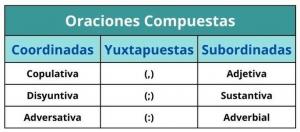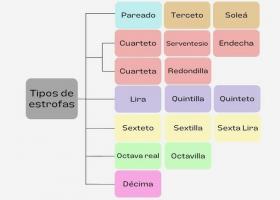Phases of mitosis and their characteristics
Mitosis is the sequence of events by which a eukaryotic cell (parent cell) produces two daughter cells with the same genetic information as the original cell. Mitosis is the stage of the cell cycle that follows interphase, where the cell prepares for the mitotic process.
The phases of mitosis are:
- Prophase
- Prometaphase
- metaphase
- Anaphase
- telophase
Next, we describe each of these stages of mitosis.
| phases of mitosis | Characteristic |
|---|---|
| Prophase |
First stage of mitosis chromosome condensation assembly of the mitotic spindle |
| Prometaphase |
rupture of the nuclear envelope Attachment of chromosomes to the mitotic spindle |
| metaphase | chromosome alignment |
| Anaphase |
chromatid separation chromosome segregation |
| telophase |
Reconstruction of nuclear envelope Disassembly of the mitotic spindle end of mitosis |
Prophase
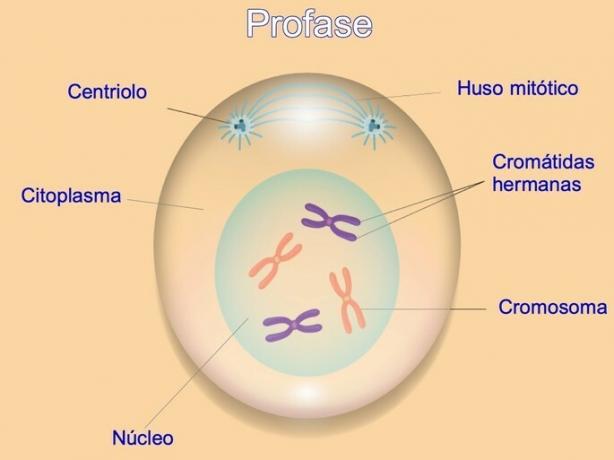 The first phase of the mitosis process is responsible for building the machinery that will allow the daughter cells to possess the genetic material that corresponds to them.
The first phase of the mitosis process is responsible for building the machinery that will allow the daughter cells to possess the genetic material that corresponds to them.
Before mitosis, during the S phase of the cell cycle, duplication of deoxyribonucleic acid DNA (genetic material) occurs, producing two identical strands that are intertwined. Separating and organizing these strands is a complicated task to ensure that each cell has its own copy of DNA.
For this, the DNA copies are condensed, separated and cut into pieces, in what is known as sister chromatids, which are seen as X's in the microscope. This process is called chromosome condensation.
Simultaneously, the cell begins to build the mitotic spindle, a spider-like structure made up of the centriole and microtubules. The organelle in charge is the centrosome, which is duplicated during the cell cycle. So by the time the cell enters mitosis there are two centrosomes.
The two centrosomes move apart along the nuclear envelope, the microtubules between them intercalate, and the mitotic spindle forms.
Prometaphase
The breakdown of the nuclear envelope is the key event of prometaphase. The centrosomes and microtubules are located in the cytoplasm, far from the reach of the chromosomes that are inside the nucleus, separated by the nuclear envelope.
In order for the chromosomes to attach to the mitotic spindle, the nuclear envelope disassembles into small vesicles.
A ring called the kinetochore is assembled around the centromere (center of the sister chromatids). This structure hooks the microtubules of the mitotic spindle so that they can be dragged towards the poles of the cell.
metaphase
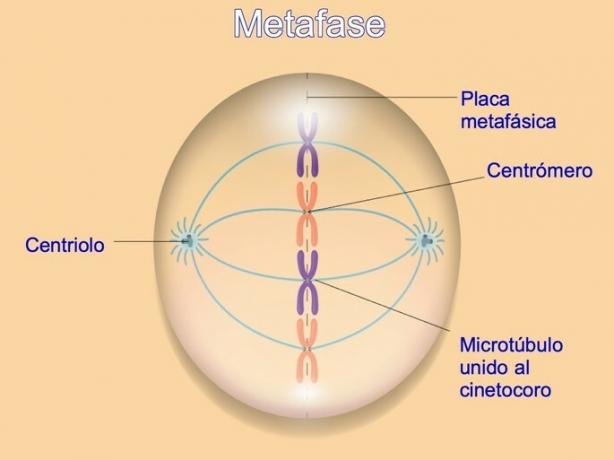 Once the chromosomes are attached to the mitotic spindle, they begin to arrange and align at the mid-equator of the cell, at what is known as the metaphase plate. The classic microscopic image of this phase shows the chromosomes in the middle of the cell.
Once the chromosomes are attached to the mitotic spindle, they begin to arrange and align at the mid-equator of the cell, at what is known as the metaphase plate. The classic microscopic image of this phase shows the chromosomes in the middle of the cell.
This is the phase of mitosis that takes the longest, about half the time, waiting for the signal of the correct alignment of the sister chromatids to move on to the next phase.
Anaphase
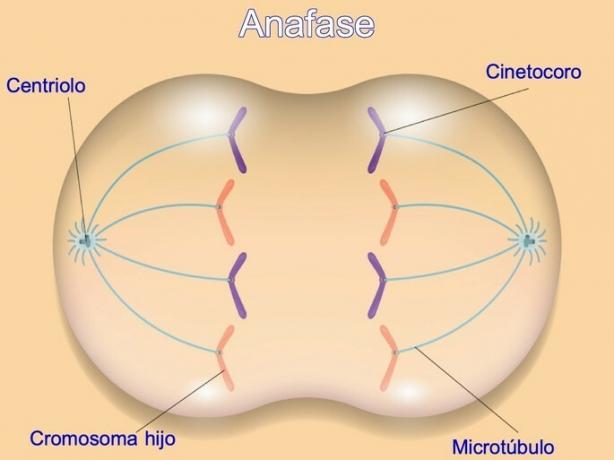 Anaphase begins when the chromatids separate, allowing each daughter chromosome to move to opposite poles of the cell, pulled by the mitotic spindle. This step is called chromosome segregation.
Anaphase begins when the chromatids separate, allowing each daughter chromosome to move to opposite poles of the cell, pulled by the mitotic spindle. This step is called chromosome segregation.
The separation of the chromosomes is produced by the mechanical force of the microtubules in the mitotic spindles, which act as pulleys.
At the end of anaphase, the daughter chromosomes are at opposite poles of the cell.
It is in this phase that a parallel process of the cell cycle begins, which is cytokinesis, the division of the cytoplasm.
telophase
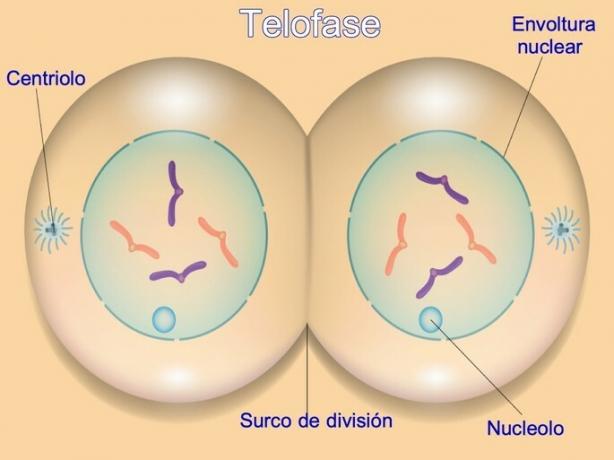 The final phase of mitosis is telophase. The main event of this phase is the packaging of the daughter chromosomes in two different nuclei after disassembly of the mitotic spindle.
The final phase of mitosis is telophase. The main event of this phase is the packaging of the daughter chromosomes in two different nuclei after disassembly of the mitotic spindle.
The chromosomes then uncoil and take on the interphase chromatin state.
Cytokinesis, that is, the division of the cytoplasm between the two daughter cells, ends shortly after telophase.
You may also be interested in seeing:
- mitosis and meiosis
- genes and chromosomes
References
Alberts, B. et al. (2008) Molecular biology of the cell. 5th ed. Garland Science. UK.
McIntosh, J. R. (2016). Mitosis. Cold Spring Harbor perspectives in biology, 8(9), a023218.

